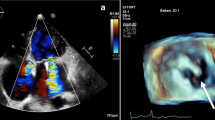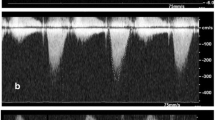Abstract
Transvalvular leakage (TVL) of a prosthetic heart valve is not negligible regurgitant flow in patients with critically low contractile function. Although the opening function of prosthetic valves has been reported, its closing function is not well understood. A man in his 70 s had a history of mitral valve replacement (MVR) with a Magna Mitral® valve for ischemic mitral valve regurgitation. He presented with dyspnea 2 years postoperatively. Echocardiography showed moderate TVL. The pulmonary capillary wedge pressure and cardiac index were 37 mmHg and 1.65 L/min/m2, respectively. Because we considered his TVL relevant, we performed re-do MVR with a mechanical valve and papillary muscle approximation and suspension (“papillary muscle tugging approximation”). His cardiac function improved postoperatively; he was discharged with New York Heart Association class I. For MVR in patients with critically low contractile function, prosthetic valves, such as mechanical valves, with small TVL are recommended.

Similar content being viewed by others
References
Baumgartner H, Falk V, Bax JJ, et al. ESC/EACTS Guidelines for the management of valvular heart disease. Eur Heart J 2017;38:2739–86.
Nishimura RA, Otto CM, Bonow RO, et al. AHA/ACC focused update of the AHA/ACC guideline for the management of patients with valvular heart disease. Circulation 2017;135:1159–95.
Banbury MK, Cosgrove DM, White JA, et al. Age and valve size effect on the long-term durability of the Carpentier-Edwards aortic pericardial bioprosthesis. Ann Thorac Surg 2001;72:753–7.
Kuehnel R, Puchner R, Pohl A, et al. Characteristic resistance curves of aortic valve substitutes facilitate individualized decision for a particular type. Eur J Cardiothorac Surg 2005;27:450–5.
Dalmau MJ, Gonzalez-Santos JM, Lopez-Rodrguez MB, et al. The Carpentier-Edwards Perimount Magna aortic xenograft: a new design with an improved hemodynamic performance. Interact Cardiocasc Thorac Surg 2006;5:263–7.
Matsui Y, Shingu Y, Wakasa S, Ooka T, Kubota S Papillary muscle tugging approximation for functional mitral regurgitation. Ann Thorac Surg;2018 (in press)
Gerosa G, Tarzia V, Rizzoli G, et al. Small aortic annulus: the hydrodynamic performances of 5 commercially available tissue valves. J Thorac Cardiovasc Surg. 2006;131:1058–64.
Dzemali O, Bakhtiary F, Steinseiffer U, et al. Hemodynamic performance of fresh and calcified aortic valve prostheses in critical low stroke volume. J Heart Valv Dis. 2008;17:317–24.
Bottio T, Caprili L, Casarotto D, et al. Small aortic annulus: The hydrodynamic performances of 5 commercially available bileaflet mechanical valves. J Thorac Cardiovasc Surg. 2004;128:457–62.
Fino C, Iacovoni A, Pibarot P, et al. Exercise hemodynamic and functional capacity after mitral valve replacement in patients with ischemic mitral regurgitation. Circ Hear Fail. 2018;11:e004056. https://doi.org/10.1161/CIRCHEARTFAILURE.117.004056.
Acker MA, Adams DH, Ailawadi G, et al. 2016 update to The American Association for Thoracic Surgery consensus guidelines: Ischemic mitral valve regurgitation. J Thorac Cardiovasc Surg. 2017;153:1076–9.
David TE, Burns RJ, Bacchus CM. Mirel valve replacement for mitral regurgitation with and without preservation of chordae tendineae. J Thorac Cardiovasc Surg. 1984;88:718–25.
Yun KL, Sintek CF, Miller DC, et al. Randomized trial of partial versus complete chordal preservation methods of mitral valve replacement. A Prelimin Rep Circ. 1999;100:90–4.
Goldstein D, Moskowitz AJ, Gelijns AC, et al. Two-year outcomes of surgical treatment of severe ischemic mitral regurgitation. N Engl J Med. 2016;374:344–53.
Acknowledgements
We would like to thank Editage (http://www.editage.jp) for English language editing.
Author information
Authors and Affiliations
Corresponding author
Ethics declarations
Conflict of interest
The authors have no conflicts of interest to declare.
Additional information
Publisher’s Note
Springer Nature remains neutral with regard to jurisdictional claims in published maps and institutional affiliations.
Rights and permissions
About this article
Cite this article
Seki, T., Shingu, Y., Wakasa, S. et al. Re-do mitral valve replacement for a bioprosthetic valve with central transvalvular leakage in a patient with ischemic cardiomyopathy: a case report. J Artif Organs 22, 177–180 (2019). https://doi.org/10.1007/s10047-018-1086-6
Received:
Accepted:
Published:
Issue Date:
DOI: https://doi.org/10.1007/s10047-018-1086-6




